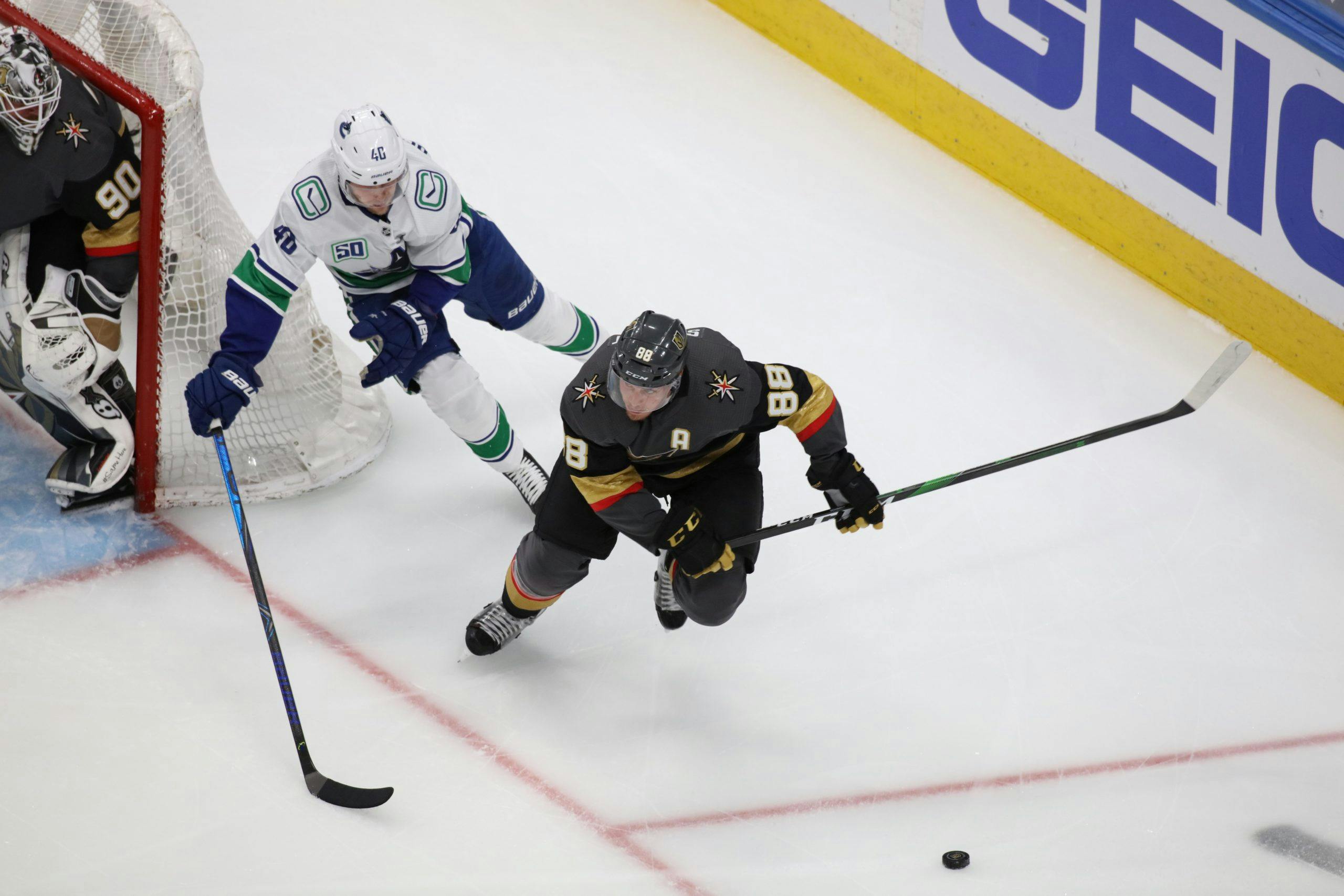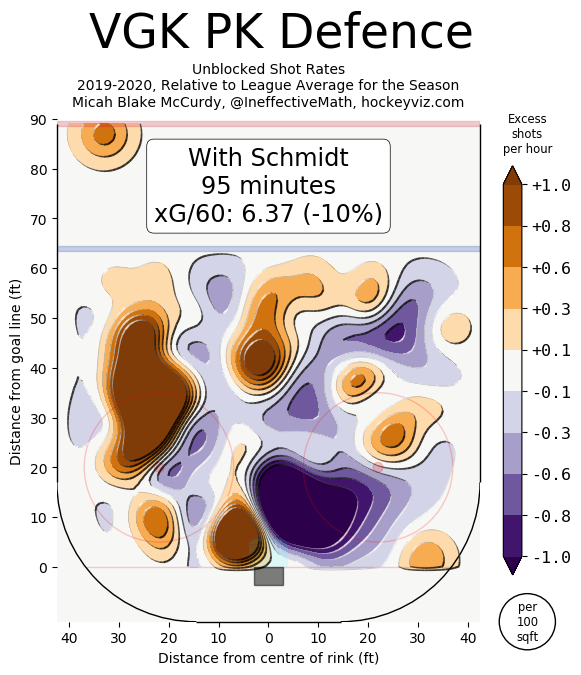The best and worst case scenarios for Nate Schmidt’s 2021 season with the Vancouver Canucks

By Jason Jhutti
3 years agoWooop! Wooop!
If you watched the Canucks’ second-round series against the Vegas Golden Knights in last year’s postseason, you may have heard a voice making an unusual sound. It turns out it was Nate Schmidt, and frankly, that’s all you may know of him. He’s a defenceman who says wooop, but there’s so much more to him than his wooop.
His introduction Zoom call with Canucks media after he was traded was a breath of fresh air. Charming, happy-go-lucky and loveable, a presence like Schmidt’s is something this city hasn’t seen in quite some time.
But what can we expect from him on the ice?
Adjusting to a new team and surroundings will take some time. Still, Schmidt’s speed and high hockey IQ will make the transition effortlessly as he did when moving to Vegas. However, in Vancouver, he already has some familiar faces in Braden Holtby and Jay Beagle to make for an easier transition into the city.
| Year | Games | Points | Avg ice time | Corsi% | Block shots |
| 2017-2018 | 76 | 36 | 22:14 | 50.4% | 121 |
| 2018-2019 | 61 | 30 | 21:57 | 50.7% | 100 |
| 2019-2020 | 59 | 31 | 21:41 | 52.9% | 91 |
The Best of Schmidt in 2021
Games: 56, Goals: 6, Assists: 27, Avg 22:30, Corsi 53%
Yet to play in a full season, an outstanding accomplishment would be if Schmidt skated in all 56 games.
Last year the St. Cloud native appeared in 59 games. He contributed seven goals, 24 assists and averaged 21:41 of ice on a well-balanced Golden Knights blue line. With great speed and higher than average hockey IQ, staying healthy and playing even in the range of 53- 56 games would be ideal for a player of Schmidt’s status.
The Canucks playoff hopes could hinge largely on whether Schmidt can stay healthy or not. A healthy Schmidt likely means playoff hockey for the Canucks, who already have a depleted blueline.
With Quinn Hughes taking the bulk of the minutes on the first power play unit, Schmidt will likely see limited time on PP2 when the first unit needs a break. As for the PK, Schmidt averaged 1:36 with the Golden Knights. His time will surely increase slightly, given that the team doesn’t have many options on the PK with Chris Tanev and Troy Stecher leaving town.
Keep in mind Alex Edler is getting older and started to tail off after 20 games or so. Managing his minutes in a compact schedule means Schmidt will be leaned on more heavily.


Even-strength is where Schmidt excels. Averaging 19:02 at five on five paired mostly with Brayden McNabb, Schmidt had 24 even-strength points but what stands out are his underlying numbers. Batting over 50% in his career in the Corsi department, Schmidt’s 2019-2020 season was no different with 52.9% while his Fenwick was 51.16%.
A reliable defenceman who can play with anyone in the lineup, Schmidt’s best place would be with Hughes while the paring of Edler and Tyler Myers will be back again for the second year running. Hughes and Schmidt’s paring would be a lethal combination, as both possess great speed and think the game like no others. Schmidt’s assist numbers could reach career highs if adjusted to an 82 game schedule with Hughes on his side.
However, spreading the wealth around could see Schmidt pair with Edler or even take one of the rookies under his wing, making for a well-balanced defensive attack that Travis Green can deploy when all healthy.
The worst-case scenario for Schmidt in 2021
Games: 26, Goals: 2, Assists: 13, Avg: 15:47, Corsi: 48%
Moving to a different team isn’t new to Schmidt, who made the move when Vegas selected him in the expansion draft; averaging under 20:00 minutes a night in Washington, the move to Vegas saw that increase to well over 21:00 as he was given a more prominent role with the Golden Knights. However, injuries can derail his season. Schmidt has missed roughly 20 games a season and has had to deal with injuries along the way. Playing in less than half of the games (in a 56 game schedule) would be a worst-case scenario for both him and the team.
At the age of 29, Schmidt still shouldn’t see a decline in his numbers. The only way he doesn’t hit the best case scenario mark is again if the injury bug bites him. The same goes for his ice time. His lowest was his sophomore campaign with 13:53, and averaged around 16:00 minutes during his first four years before having a breakout 2017-18 season.
Hitting the 20-minute mark has been something Schmidt has become accustomed to since his time in Vegas. Anything less than 20 will be a disappointment, and the worst-case scenario would be if he were in the 15-minute range, which would mean he hasn’t been playing well and hasn’t acclimated himself yet.
What else does a successful season look like?
His former teammates love him, and he can brighten up any locker-room. Having his personality, experience and leadership on the team will be a warm welcome for a young and inexperienced blue line that lost Tanev and Stecher.
Playing sound defensively will make the new campaign a successful one.
What else does an unsuccessful season look like?
In an unprecedented season, adjusting to a new environment and the unknown of COVID-19 is hard for anyone. Like every player coming to a new team, he won’t want to get off to a slow start (obviously). Getting off to a slow start could cause a lack of confidence and see him head in a downward spiral early on in his Canucks’ tenure.
As previously mentioned, staying healthy is key for Schmidt. With already a thin, inexperienced backend, having Schmidt hurt could mean curtains for the postseason.
Schmidt is an upgrade on the top four and will provide a complimentary offensive punch if he isn’t paired with Hughes. Schmidt brings stability and speed, which lacked on the backend and watching him apply his craft will be easy on the eyes.
Recent articles from Jason Jhutti





